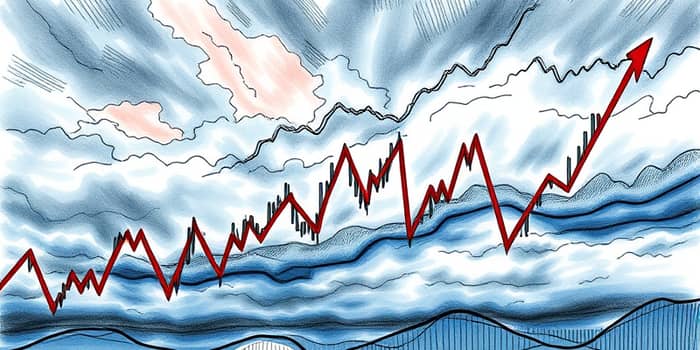
In today's fast-paced markets, understanding volatility is more than an academic exercise; it's a survival skill for traders and investors alike. By dissecting the nature of price swings, mastering measurement techniques, and applying strategic insights, market participants can transform uncertainty into opportunity. We will explore foundational concepts, practical tools, and advanced frameworks necessary to navigate turbulent trading environments with confidence and precision.
At its core, volatility is a statistical measure of price variation over time, typically expressed via standard deviation or variance. Analysts often look at it as a key indicator of risk, evaluating how wildly a security's returns can oscillate. A high volatility percentage suggests both heightened fear and potential reward, as assets that swing violently often promise larger gains—and losses.
Investors and risk managers monitor volatility across various horizons—daily, weekly, monthly, or annualized—to calibrate portfolio exposure. It serves as the backbone for pricing derivatives such as options, where forecasts of future price swings determine premium costs. Understanding volatility is thus essential for anyone seeking to anticipate market shifts or hedge against extreme price movements.
Historical volatility, also known as realized volatility, is calculated based on past price data, usually through the standard deviation of returns over a specified lookback window (for example, 20 or 90 days). Traders compute daily returns, subtract the average return, square the differences, and average them before taking a square root. This method reveals how much an asset has actually fluctuated.
Implied volatility, by contrast, is derived from option prices using models such as Black-Scholes. It captures the market's expectations of future swings and is reflected in option premiums: higher implied volatility makes options more expensive. Unlike historical metrics, implied volatility can spike ahead of earnings announcements or during periods of uncertainty, providing a forward-looking gauge of risk.
Complementary metrics include variance (the square of standard deviation), beta (an asset’s volatility relative to the overall market), and R-squared (the proportion of movement explained by a benchmark index). Together, these indicators form a multi-dimensional view of an asset's risk profile and help traders identify relative and absolute sources of uncertainty.
Price swings seldom occur in a vacuum. Volatility often surges in response to:
Understanding these triggers enables market participants to anticipate periods of heightened uncertainty and adjust strategies proactively.
Accurate volatility estimates underpin critical decision-making processes:
By integrating volatility metrics into models, market participants can maintain robust frameworks for both everyday trading and crisis management.
The advent of big data and machine learning has revolutionized volatility analysis. Platforms like Kensho ingest news feeds and economic data to compute real-time volatility scores. Quantitative desks deploy algorithmic systems that instantly adjust position sizes based on changing volatility regimes.
Leading-edge toolkits often include:
These capabilities allow traders to capture fleeting opportunities and manage risk with unprecedented agility.
Investors tailor their approach to market volatility through distinct strategies:
Low-volatility strategies aim for steady, smaller returns to protect capital in uncertain markets. Funds employing this style often hold defensive sectors, use dividend-paying stocks, and apply strict risk controls. In contrast, high-volatility strategies target aggressive profit from short-term price swings, capitalizing on momentum and mean-reversion patterns.
Another common tactic is hedging: using options or volatility products to offset potential losses or to speculate on volatility trends. Instruments like the CBOE VIX allow investors to directly trade anticipated spikes in market stress.
Opportunity arises when disciplined traders exploit price swings. Instruments such as volatility ETFs or futures enable participants to profit from expectation adjustments without directional bias. Prospective gains can be substantial when volatility moves deviate sharply from historical norms.
Conversely, volatility can be a formidable adversary. Rapid price shifts may trigger forced liquidations, margin calls, and panic-selling. During extreme events, liquidity evaporates, widening spreads and magnifying losses. Effective risk management protocols must anticipate these scenarios to prevent catastrophic drawdowns.
Relying solely on historical data can underestimate future risk in times of regime change. Implied volatility may embed market overreactions, requiring validation through alternative indicators. The optimal approach combines historical and implied volatility measures with qualitative assessments of underlying drivers.
Key best practices include regularly recalibrating volatility forecasts to reflect current conditions, stress-testing portfolios against hypothetical high-volatility events, and maintaining clear communication between trading, risk, and compliance teams.
The following table highlights the essential volatility metrics, their measurement methods, and key use cases.
Mastering volatility is a journey that blends quantitative rigor with qualitative insight. By understanding how to measure, interpret, and respond to market fluctuations, participants gain a strategic edge. Whether acting as a risk manager, an active trader, or a long-term investor, integrating volatility analysis into your decision-making process will enhance resilience and unlock new opportunities in every market cycle.
Embrace volatility not as an obstacle but as a dynamic force you can harness—transforming uncertainty into a powerful ally on the path to financial success.
References













